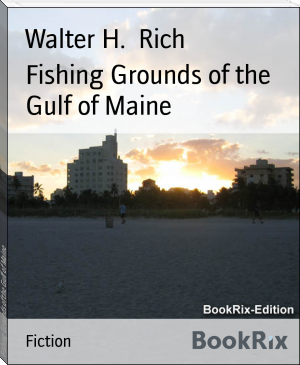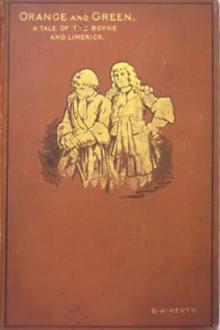Fishing Grounds of the Gulf of Maine, Walter H. Rich [readnow txt] 📗

- Author: Walter H. Rich
Book online «Fishing Grounds of the Gulf of Maine, Walter H. Rich [readnow txt] 📗». Author Walter H. Rich
The Klondike. This ground lies 15 miles S. by E. from Bald Head and is 3 miles long by 2 miles wide. The bottom consists of ridges of rocks--a "blistery" bottom (abundance of "sea pears", "sea squirts", and other marine growths of a similar nature). It is a cod and cusk ground all the year. Haddock are present from January to April and hake from September to December. Depths are from 75 to 80 fathoms over mud and rocks. Fishing on this ground is by hand line and trawl by small boats and sloops, with an occasional trip by larger vessels in winter.
Sagadahoc. This ground is SE. by E. from Halfway Rock 22 miles and S. ½ W. from Seguin 17 miles. It has a broken bottom of rocks "blisters," and mud, and is 3½ miles long by 2½ miles wide, with depths from 50 to 80 fathoms. It is a cusk ground the year around as well as a year-around cod ground, also, but this fishing is at its best in the spring. It is a hake ground on the deeper soundings from September to December. Fishing here is carried on by trawling, hand-lining, and gill netting.
Big Ridge, or Doggetts. These names are given to a piece of fishing ground about 8 miles long by 2 miles wide lying 18 miles SE. by S. ½ S. from the lightship at Portland or 14 miles SE. by E. from the same point, according to which part it is desired to fish upon. It has from 45 on the shoal in the center to 80 fathoms of water on the deeper parts over a bottom of rocks and gravel on the shallower portions and of mud about the edges and in the deeper soundings.
Cod are abundant here in spring and fall on the shoaler parts of the bank and are present the year around on the muddy edges and in the deep water about it; the spring school, however, is the largest. Hake are found in spring and summer on the edges in deep water. A few haddock may be taken in the winter and spring, January to April, inclusive. Cusk can be taken the year around, the best fishing being in spring and winter. The February cusk school is the largest, and the best catches are made in the deep water about the edges of the ground. Fishing here is principally by trawling, but hand-lining and gill netting also are employed, the latter method in continually increasing volume.
Lying off Cape Porpoise, between the bearings of SE. and SSE., and at distances varying from 6 to 8 miles, are a number of small, rocky, or pebbly bottoms having depths ranging from 18 to 25 fathoms. During certain seasons these abound in cod and haddock and are visited by the fishermen of the vicinity.
Tanta. This ground is S. from Cape Elizabeth, the center being distant 12 miles. It is 2 to 3 miles in diameter and has depths of about 40 fathoms over a bottom of broken ground of rocks and gravel. This is a spring and summer fishing ground for cod. Haddock are present here in winter, the best fishing being in January, With a few in the spring. Trawls, hand lines, and gill nets are operated here. Outside of Tanta (S. 3 miles), in 80 and 90 fathoms on muddy and broken bottom (a "punkin" bottom), hake and cusk are abundant in February and March, the hake remaining into the summer. Herring and mackerel usually are present here in those years when their schools arc abundant in this locality.
Winker Ground. The ground lies in a NE. and SW. direction, about 2 miles long by 1/4 mile wide. The bottom is broken, of mud, rocks, and sand, with depths from 35 to 40 fathoms. Outside of the 40-fathom depth the ground is mostly of mud. This is a cod ground in the early spring. haddock and hake being here from July 1 to September 1. Haddock are found here also from March 10 to April 20. This is a small-boat ground, fishing being done mainly by trawling and a certain amount of gill netting. Marks: Run 5 miles SW. from the whistling buoy off Cape Elizabeth. or until Ram Island Winker Light shows out by Cape Elizabeth.
Long Hill Ground. This lies SSE. from Cape Elizabeth, 9 miles to the center. Marks: Bring the western light of Cape Elizabeth on the middle of Johnsons Woods on the high land of the cape, which with the course given before, will bring to the center. This lies in a SSE. and NNW. direction and is a rocky bottom, having 60 to 70 fathoms. Haddock are taken here from October to January 1 and from February 15 to April 1. Cod also occur at about the same season.
Outer and Inner Bumbo. These are two small rocky ridges bearing SE. from The Nubble and extending toward Boon Island. They begin near the main shore and extend nearly to the island. Depths are from 8 to 20 fathoms over a broken piece of bottom, except for a mud gully about 3 miles from the main running NE. and SW. about 3 miles long. In general, this is a small-boat ground, where good catches of cod and haddock are made in spring and fall, especially in the latter season, with good hand-lining for cod in July and August in 8 and 10 fathom depths. These grounds are fished by trawl, hand line and gill nets. All the grounds between Cape Porpoise and Boon Island are good lobster grounds.
Wells Bay. Beside a number of small, rocky patches of fishing ground of less importance, resorted to chiefly by small-boat fishermen and by gill netters from Portsmouth, Wood Island, and Cape Porpoise; this ground has a good cod shoal for spring and winter fishing, which also furnishes good haddocking from April to October. The depths on this are from 25 to 30 fathoms. These are fished by trawl, hand lines, and gill nets (perhaps mainly by the latter) operated by the smaller fishing vessels, chiefly from Portsmouth, Wood island, Cape Porpoise, and Portland.
Lightons. This ground is SE. by E. 8 miles from Cape Porpoise, 3 miles long by 2 miles wide, with depths of 25 to 30 fathoms over a generally gravelly bottom. This is somewhat more productive as a haddock ground from January 1 to March, but cod and hake are numerous in the same season also. A small amount of cod may be taken here in the summer. This is a good lobster ground.
Tracadie; The Acre. This bears NE. by E. from Boon island, distant 5 miles. It is 1 mile in diameter and has a depth of 50 fathoms over a bottom of rocks and gravel. It is a good haddock ground all the year; a cod ground in August, when these fish are "jigged"; a hake ground from April to October; and a cusk ground the year around.
Old Southeast. Extends from the shore soundings at White Island (one of the isles of Shoals) 7 or 8 miles SE. nearly to Jeffreys in a long, rather narrow point. It is a piece of broken ground with a hard bottom, having depths running from 20 fathoms on the inner parts to 50 fathoms farther out and deepening suddenly on all sides to the mud about it. Fish and their seasons are as on Blue Clay, haddock being most abundant on the eastern edge from January through March. This is growing steadily in importance as a gill-netting ground.
The Prairie. This name has been given to a flat ground of generally level bottom, lying E. by N. from Boon Island 7 miles. It has depths of from 41 to 50 fathoms over mud and gravel, rising out of 60 fathoms over the muddy ground about it. It extends in a generally ENE. by WSW. direction, 2 miles long by 1 mile wide. It is a "blistery" ground, the presence of these growths on a rocky or gravelly bottom usually meaning good fishing. This is principally a haddock ground, with the best season from mid March to the 1st of May. This is a small-boat and gill-netting ground. It is also visited to a considerable extent by the larger vessels of the Portland fleet in the severer weather of the winter and early spring because of its accessibility.
Blue Clay Ground. also called Southeast Ground. This bears S. by E. from Boon Island. from which it is distant 8 miles. The form of the ground is roughly square and is from 4 to S miles across. Depths here range from 30 on the shoalest parts to 60 fathoms, the bottom being of tough blue clay. The water deepens suddenly on the muddy ground all about it. It is one of the best winter haddock grounds in this vicinity, particularly the eastern edge, which is much resorted to by haddock trawlers from January through March, when this species is most abundant here. It is a good winter cod ground, also.
A long, narrow strip of hard bottom, separated from the Blue Clay by a narrow mud gully of somewhat greater depth, is called the Prong. Depths here run from 30 fathoms on the inner parts to 70 fathoms offshore. This piece furnishes a very suitable bottom for operating gill nets and is much visited by this type of craft. The Prong lies S. by E. from Cape Porpoise 17 miles. Marks: Bring Acre Hill in line, Notch of Agamenticus at the distance from Cape Porpoise just given. From the Isle of Shoals the Prong is distant 10 miles SE. by E.
Duck Island Ridges. These are two narrow rocky ridges running from Duck Island (one of the Isles of Shoals) toward Boon Island. reaching within I mile of the latter. Depths are from 25 to 30 fathoms. These are good cusk and haddock grounds in the winter and spring, the cusk remaining on the ground also from April to October. This is a cod ground in winter and spring, the fish being taken on the "bobber trawl." which is a trawl of the ordinary type buoyed to "set" 1 fathom or so from the bottom. It is a hand-line ground in summer for cod and pollock. Both small boats and vessels, line trawlers, and gillnetters operate here. It is also a lobster ground.
Boon Island Rock Ground. This ground begins ½ mile eastward of Boon Island Ledge and runs in an ESE. direction 2 or 3 miles from the ledge. It has a bottom of sharp rocks and clay and depths from 40 to 60 fathoms. It is an excellent fishing ground for cod, haddock, and cusk and is one of the best winter fishing grounds for haddock in this vicinity. It is fished mainly by line trawlers but is not much used as yet by gill-netters, being a somewhat difficult piece of bottom for them.
Tower Ground. This is a winter haddock ground having depths averaging 50 fathoms over a ridgy and broken bottom. This is about 3 miles long by 2 miles wide and bears about SE. from Boon Island. Marks: Bring Boon Island Light on the Peak of Mount Agamenticus, running off until the top of the tower and the top of the mountain are level, perhaps 6 miles from Boon Island.
Ten Acre or Nipper Ground. Extends S. ½ E. from Boon Island 6 miles and E. from Isles of Shoals 7 miles. This shoal is about 1/4 mile wide and has 18 to 20 fathoms over clay and mud, the ground sloping gradually to 50 or 60 fathoms near the edge. This is a good fishing ground for cod, haddock, cusk, and pollock in the spring, while on the muddy edges hake are abundant in September. Marks: White Hills over Boon Island on center (these cross bearings meet near the center of the ground); also, the Black Hill W. of Portsmouth over the Star Island of the Isles of Shoals





Comments (0)